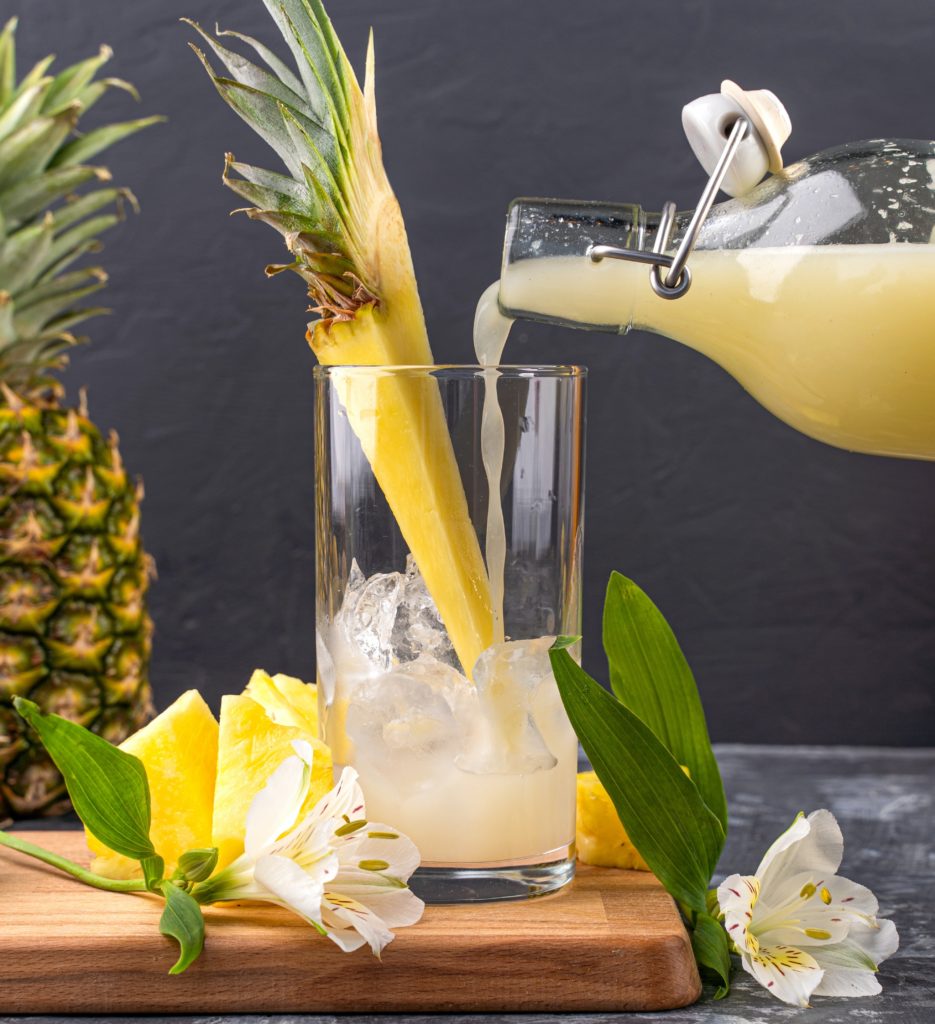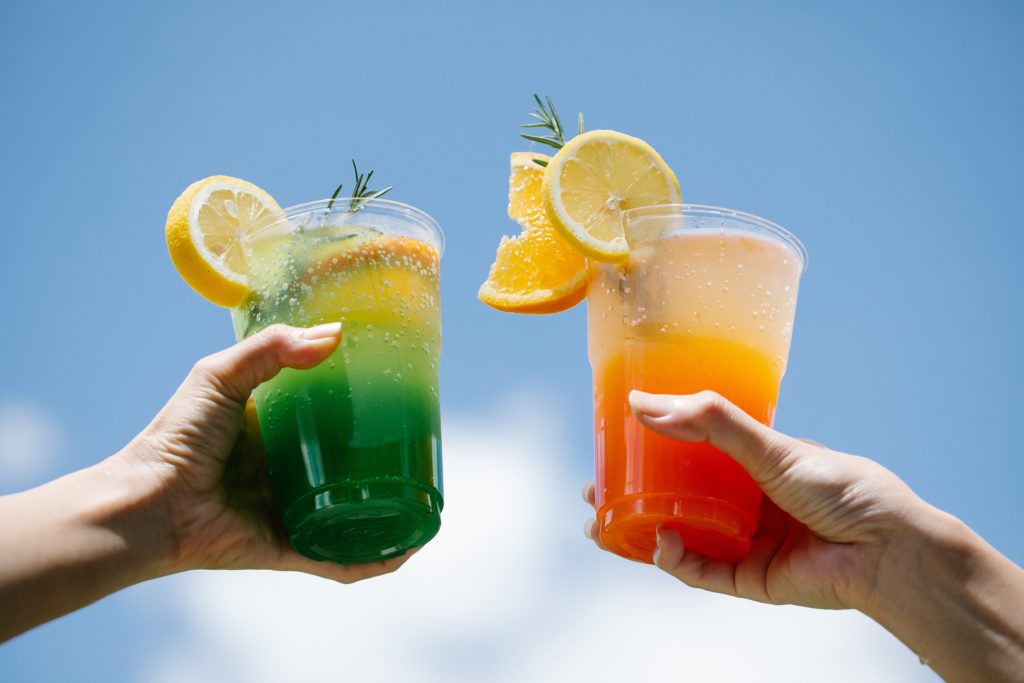Spanish-speaking countries are well known to be fond of good food and drinks. Moreover, beverages represent an important part of Latin American culture. So, learning how to order what you want, whenever you want it, might be challenging if you don’t know the basics on Spanish drinks. Don’t panic, you’ve come to the right place!
In this post, we’ll cover the most essential and common phrases for ordering drinks in Spanish. Plus, we will go through words and specific expressions or phrases needed in different scenarios, from how to order in Spanish, to different types of coffees and juices, to some of the most popular Spanish cocktails. Let’s get started!
Ordering Drinks in Spanish: The basics
Suppose you feel a little bit antsy when ordering a soda, a cup of coffee, or a glass of wine in Spanish. In that case, there are a few key phrases to remember that will come in handy.
Let’s start with the level of formality. In restaurants, waiters will usually address you with the personal form tú. Nevertheless, there are other places where the approach is more formal, so they’ll use usted instead of tú.
Let’s start with the first phrases you will hear when you start a conversation with the waiter. The expressions might be slightly different depending on the Latin American country, but they’ll generally be pretty close to the most common ones:
| Phrase | English |
| ¿Qué quieres beber / tomar? | What do you want to drink? |
| ¿Qué deseas tomar / beber? | What would you like to drink? |
| ¿Qué vas a tomar / beber? | What will you have to drink? |
| ¿Qué te pongo? | What do you want to have? / What would you like? |
| ¿Qué te traigo? | What can I get for you? |
| ¿Qué te sirvo? | What will you have? |
You can order your favorite drink in Spanish very straightforwardly, without sounding rude or impolite. You simply order it with a simple command, but a por favor will always be appreciated. The most common and popular way of ordering is to use indefinite articles un or una, followed by the name of the drink in Spanish. Let’s see some of these phrases:
| Phrase | English |
| Dame un… | Give me a… / I’ll have a… |
| ¿Me puedes dar un…? | May I have a…? |
| Quiero un… | I want a… |
| ¿Me das un…? | Can you give me a…? |
| ¿Me pones un…? | I’ll take a… |
| Tráeme un… | Get me a… / Bring me a… |
| Me vas a traer un… | Can you bring me a…? |
| Voy a tomar un… | I’ll have a… |
| Tomaré un… | I’ll have a… |
| Me gustaría un… | I would like to have a… |
| Quisiera un… | I would like to have a… |
Let’s see an example:
- Waiter: Good afternoon and welcome! What would you like to drink? – ¡Buenas tardes y bienvenido! ¿Qué deseas tomar?
- Customer: Please, get me a large latte. – Tráeme un café con leche grande, por favor.
If you’re hungry and want to know how to order in Spanish, we recommend this post on ordering in restaurants.
Hot drinks
Coffee
Most people are big coffee fans, and we get it. We all can use a kick of caffeine in the mornings and even in the evening. Moreover, this drink is something we can order anywhere globally. Still, if you are not sure how to order a coffee in a different country or place, it can be difficult. What is called a certain way in your country may be completely opposite in another, or it may not even exist.
Don’t worry, we’ve got you covered whether you want it black, with milk, iced, or even with alcohol. In this section you’ll learn the most common styles of coffee in Spanish.
Café solo – Espresso: This is a strong coffee shot, taken with no milk. It’s up to you whether to add sugar. A café solo is typically very strong, so be prepared.
Cortado: Cortado is an espresso or black coffee over which a splash of milk is poured. It has much less milk, smaller than a regular latte.
Café Americano – Long espresso, Caffè Americano: This is an espresso made with a lot more hot water to make a bigger drink. For this reason, it is much milder than any other black coffee.
Café con leche – Latte, Coffee with milk: This is perhaps the most popular and well-known coffee in Latin America. Ideally, it is served in a large cup, mixing 50% black coffee and milk. The amount of milk can vary according to the person’s taste.
Capuchino – Cappuccino: Also an espresso-based coffee, with steamed milk and topped with a layer of milk foam and chocolate powder.
Moca – Mocha: This is a variant of “café con leche”, prepared with milk, chocolate powder or chocolate syrup. The ideal balance is 50% for each ingredient.
Blanco y Negro: A typical summer coffee usually consumed after lunch or as an afternoon snack. It is the midpoint between a coffee and a dessert. Served ice cold, it is considered refreshing and very easy to prepare. It is made from 4 basic ingredients: 1 cup of espresso coffee, sugar, ice cream, and a lemon peel.
Other types of coffee are trendy in some Latin American countries. Let’s have a look at some of them.
| Popular coffee in Spanish | What it is | Country |
| Bombón | It is a “café cortado” with an amount of condensed milk. | Spain, Argentina |
| Manchado or Leche Manchada | Cup of milk with a small amount of coffee, not more than a drop. | Spain |
| Carajillo | Cup of hot coffee with an alcoholic beverage usually brandy, rum, or “aguardiente”. | Spain, Colombia |
| Pocillo | Small cup of black coffee. | Argentina |
| Jarrito | Large cup of black coffee. | Argentina |
| Lágrima | Cup of coffee with a small amount of milk, not more than a drop. | Argentina |
| Negrito or Cargado | Short, highly concentrated, sugar-free espresso. | Venezuela |
| Guayoyo | Black coffee, lighter or watered down than “negrito”. | Venezuela |
| Marrón (claro or oscuro) | Venezuelan latte variation prepared with 50% coffee and 50% milk (claro) or 70% coffee and 30% milk (oscuro). | Venezuela |
| Tetero | Cup of milk with just a few drops of coffee. | Venezuela |
| Tinto, Tintico | Colombian variation of Espresso. | Colombia, Venezuela |
| Perico or Pintado | Black coffee with a small amount of milk. It varies according to the region. | Colombia |
| Café de olla | Cup of coffee prepared in a pot with cinnamon, unrefined brown sugar, bitter chocolate and anise. | México |
Finally, here’s a coffee-related vocabulary list:
| Spanish | English |
| Café | Coffee |
| Granos de café | Coffee beans |
| Café molido | Ground coffee |
| Taza | Cup, Mug |
| Leche | Milk |
| Leche entera | Whole milk |
| Leche semidesnatada, Leche baja en grasa | Reduced fat milk |
| Leche desnatada | Skim milk |
| Leche de almendra | Almond milk |
| Leche de soya | Soy milk |
| Azúcar | Sugar |
| Endulzante | Sweetener |
| Sin azúcar | Without sugar |
| Canela | Cinnamon |
| Espuma | Foam |
| Doble | Double |
| Caliente | Hot |
| Frío | Cold |
| Descafeinado | Decaffeinated |
| Helado | Iced |
| Instantáneo | Instant |
| Pequeño, Chico | Small |
| Mediano | Medium |
| Grande | Large |
Hot chocolate
Hot chocolate or chocolate caliente is famous in Spain and Latin America for breakfast. Chocolate drinking establishments are known as chocolaterias. Hot chocolate can accompany cakes or pastries in general, and it is fantastic for dipping churros, cookies, or even fruits. Here’s the basic vocabulary list for hot chocolate in Spanish:
| Word | English |
| Chocolate caliente | Hot chocolate |
| Taza | Cup, Mug |
| Mojar | To dip |
- Waiter: What will you have? – ¿Qué te sirvo?
- Customer: I’ll have a cup of hot chocolate and two cookies, please. – Voy a tomar una taza de chocolate caliente y dos galletas, por favor.
Tea
To begin with, the word for tea in Spanish is pretty easy: té.
Different types of tea are popular around Latin America, so you can often choose between a few varieties if tea is your thing. Here’s a vocab list of herbal teas and infusions that can hydrate you, reduce stress, and even lower hypertension levels.
| Type of tea | English |
| Té negro | Black tea |
| Té verde | Green tea |
| Té de jamaica | Hibiscus tea |
| Té de valeriana | Valerian tea |
| Té de hierbas | Herbal tea |
| Té de limón | Lemon tea |
| Té frío, Té helado | Iced tea |
| Manzanilla | Chamomile |
| Tilo | Lime blossom |
- May I have hibiscus tea please.? – Por favor, ¿me puedes dar un té de jamaica?
Soft Drinks
In Latin America, everyone is saying brand names instead of refresco. It’s pretty normal in a restaurant to hear people order soft drinks in Spanish with a phrase like “Dame una Coca-Cola, por favor.”
Just as in English there are a few words for soft drinks, the same applies in Spanish. Here are the basics:
| Drink | English |
| Refresco | Soft drink, soda |
| Soda | Soft drink, soda |
| Gaseosa | Soft drink, soda |
| Cola | Cola |
- Bring us a beer and two orange sodas. – Tráenos una cerveza y dos gaseosas de naranja.
Refreshing Drinks and Juices
When it comes to fruit drinks, you’ll have quite a selection since Latin America has such a wide variety of tropical fruits. You’ll find fruit juices on restaurant menus, you’ll find dedicated fruit juice or smoothie establishments, and you’ll find fruit juice stands in markets and on roadsides. Good luck trying all the varieties!
To order a fruity drink in Spanish, just use one of the phrases we learned for ordering, then one of these next ones to describe how you want it juiced, and then the name of the fruit or fruits. We will show you some of the most popular and well-known ones throughout Latin America.
| How your drink is juiced | English |
| Jugo de… (Latin America) | … juice |
| Zumo de… (Spain) | … juice |
| Batido de… | … smoothie |
| Fruit | English |
| Naranja | Orange |
| Lima | Lime |
| Limón | Lemon |
| Toronja, Pomelo | Grapefruit |
| Manzana | Apple |
| Durazno | Peach |
| Mango | Mango |
| Maracuyá, Parchita | Passion fruit (lots of varieties) |
| Papaya, Lechoza | Papaya |
| Guayaba | Guava (a hard green apple-sized fruit with dense flesh and a mild sweetness) |
| Guanábana | Soursop (a big spiky green fruit with white flesh of medium sweetness) |
| Piña, Ananá | Pineapple |
| Melón | Melon |
| Sandía, Patilla | Watermelon |
| Uva | Grape |
| Fresa, Frutilla | Strawberry |
| Mora | Blackberry (often much bigger varieties than in North America) |
- I’ll have a papaya smoothie and my wife wants an orange juice. – Tomaré un batido de lechoza y mi esposa quiere un jugo de naranja.
Wine
If wine is what you’re looking for, you’ll probably make your choice based on the main dish you’ve ordered, or perhaps even in response to whatever your dinner partners have ordered. Whether by the glass or by the bottle, here’s a handy list of words and phrases for ordering wine in Spanish.
| Phrase | English |
| Una copa de… | A glass of… |
| Una botella de… | A bottle of… |
Now, try to combine the phrases we’ve shown you before. Let’s see some of them:
| Phrase | English |
| Tráeme una botella de… | Bring me a bottle of… |
| Quiero una copa de… | I want a glass of… |
| Nos gustaría una botella de… | We would like a bottle of… |
| Tomaré una copa de… | I will have a glass of… |
- We will have a bottle of white wine. – Nos vas a traer una botella de vino blanco.
And finally, here are the translations for the most common types of wines.
| Wine | English |
| Vino tinto | Red wine |
| Vino blanco | White wine |
| Vino rosado | Rosé wine |
| Vino espumoso, Cava | Sparkling wine, Bubbly |
| Vino generoso, Vino fortificado | Fortified wine, Port |
| Sangría | Sangria |
- Can I have a glass of red wine, please. – ¿Me das una copa de vino tinto? Por favor.
Beer
Beer is probably the most widely consumed alcoholic beverage in the world. We all love it, there is no question! The way this magical drink is affectionately called varies widely among Latin American countries.
Cerveza is the straight translation for beer in Spanish, but that’s just the beginning of the story.
Do you know what else they call beer in Spanish? There are so many unique names for this frosty beverage! Let’s take a tour through the vast vocabulary for beer in Spanish!
| Beer in Spanish | Country |
| Chela | México, Guatemala, Chile, Perú |
| Birra | Argentina |
| Pola, Amarga, Agria | Colombia |
| Chela, Biela, Pezcuezuda | Ecuador |
| Birra, Fría, Negra, Catira, Curda, Polarcita | Venezuela |
| Fría | Puerto Rico |
| Fría, Pequeña, Birra | República Dominicana |
| Cristal, Larger, Lagarto, Birra, Cerbatana, Dispensada, Fría, Rubia, Negra | Cuba |
Latin Americans would generally order a beer using one of the phrases we saw above:
- I’d like to have a beer, please. – Me gustaría una birra, por favor.
To order a beer in Spain, on the other hand, it’s a completely different story because it depends mainly on the size or presentation of the beer.
Botellin or Quinto: This is the smallest bottle in which beer is served (a botellín) and at 200ml is one-fifth of a liter (un quinto). The quinto is arguably the most popular presentation in northwest Spain.
Tercio: This is a standard-sized bottle served in bars and restaurants. At a third of a liter (un tercio), it’s a reliable 33ml bottle.
Caña: This is the presentation par excellence at bars, served on draft. You can order a caña all over Spain. In general you can expect about 200ml, though it really depends on the size of the bar’s glassware.
Doble: As its name suggests, a doble is a glass of draft beer twice the size of a caña.
Jarra: This is the biggest draft you can generally order in Spain, similar in concept to a pint. The jarra is usually served in a big glass mug.
Corto, Zurito, or Penalti: This is a trendy serving of beer in regions such as Valladolid or Salamanca. The cortos or zuritos usually measure between 100ml and 140ml.
Cerveza sin alcohol: This is a non-alcoholic beer. It’s the only one where you actually refer to cerveza when you’re ordering your beer in Spanish!
Popular Spirits, Liqueurs, and Cocktails
Let’s take a look at a few of the most common Latin American liquors you’re likely to come across, including a couple of essential Spanish cocktails.
Ron (the Caribbean): Rum is distilled from sugar cane molasses, which is then cut with distilled water to an alcohol content of 40%. The favorite way to drink it is in Cubas Libres or Mojitos.
Pizco (Peru and Chile): This liquor is produced in both countries and is always served with lemon juice, sugar and egg white over ice as a Pisco Sour.
Tequila (Mexico): This strong liquor is distilled from the agave plant, and can be clear or yellow in color.
Mezcal (Mexico): This variety of tequila is extremely popular throughout Mexico and is the essential ingredient in Margaritas and many other fun cocktails.
Mamajuana (Dominican Republic): This is a traditional infusion, generally containing cinnamon, bark, roots, or other aromatics. The mixture can be infused in different alcohols to create endless flavor combinations. Once it’s been steeped for weeks, Mamajuana is sipped as an appetizer.
Aguardiente (Latin America): This clear liquor, also known as guaro in Colombia, is a distilled liquor made from sugar cane, often also with aniseed. Its artisanal production makes aguardiente a nice natural drink. The usual way to drink it is cold and neat, in small glasses.
Grappamiel (Uruguay): This is a sweet liquor made from grappa and honey, often incorporating other aromatics. It can be enjoyed on ice, sometimes cut with mineral water. It is very trendy during Carnaval.
Mojito (Cuba): This famously refreshing drink is made from rum, mint, lime, and sugar, sometimes with additional herbs, and served on ice.
Cuba Libre (Cuba): This classic, easy, and refreshing Cuban cocktail is prepared by mixing white rum, cola, and lime juice. Served cold, it’s ideal for those hot days under the Caribbean sun.
Tinto de verano (Spain): This typical Spanish drink combines red wine, lemon soda, ice, and a lemon peel. It is ideal served as an after-dinner drink, especially in hot months. This popular beverage emerged in Spain in the mid-twentieth century and can be easily found in verbenas and terraces.
Drinks in Spanish from South America
Latin America is a melting pot of races, and drinks are a clear example of the great diversity of cultures that come together in our continent. We want to tell you which are the most traditional drinks in Latin America.
| Drinks in Spanish | What it is | Country |
| Mate | Argentinian infusion made with “yerba mate” leaves, placed in a small container, which is called “mate”, “cuia” or “porongo”, depending on the region. | Argentina |
| Limoncello | Lemon-based alcoholic beverage. | Argentina |
| Chicha | Artisanal beverage prepared from the fermentation of cereals, like rice, and fruits. | Bolivia, Chile, Colombia, Ecuador, Peru, Venezuela and Central America |
| Cholado | It is a mix between a frozen dessert, a fruit cocktail, and a drink. | Colombia |
| Masato | Fermented cold drink typical of Colombian Andean region. It is prepared with rice, sugar, water, cinnamon and cloves. | Colombia |
| Canelazo | Traditional hot drink from Ecuadorian mountains prepared with boiling water, cinnamon, sugar or “panela” and aguardiente. | Ecuador |
| Champús | Typical and very popular drink based on “panela” honey, “chancaca”, corn, local fruits and spices. | Ecuador, Colombia and Peru |
| Aguas frescas | Refreshing drinks prepared with fruits or seeds, ice and sugar. The most popular are lemon with chia, horchata, hibiscus, and tamarind. | Mexico |
| Atol or Atole | Traditional hot beverage prepared with water, corn flour, cinnamon, vanilla extract, milk, and salt. | Mexico |
| Pulque | Mexican fermented beverage par excellence made from the fermentation of “maguey”, also popularly known as “Aguamiel”. | Mexico |
| Tereré | Paraguay’s traditional hot beverage made from “yerba mate” and medicinal herbs. | Paraguay |
| Chicha morada | Traditional Peruvian drink whose special ingredients are purple corn or “maíz morado”, water, pineapple, sugar, lemon and cinnamon. | Peru |
| Coquito | Traditional Christmas drink made from white rum, eggs, grated coconut, ice, milk, cinnamon, evaporated and condensed milk. | Puerto Rico |
| Horchata de chufa | Refreshing drink prepared with water, sugar, wet tigernuts, cinnamon and lemon peel. | Spain |
| Ponche de crema | Typical Venezuelan Christmas drink made from egg yolks, milk, sugar and brandy. | Venezuela |
Conclusion
With that, we’ve covered how to understand your server at the restaurant or bar, we’ve looked at how to order your drinks in Spanish, and of course we’ve learned a whole bunch of different types of drinks so you know what you’re getting.
We hope you enjoyed getting to know all these drinks in Spanish, and encourage you to try some new ones whether you’re traveling in Latin America or just experiencing some new flavors in your hometown. Cheers! – ¡Salud!
Exercise
Rather than our usual quiz to get you practicing your new vocabulary, this post on drinks in Spanish obviously calls for an entirely different type of exercise!
If you like piñas coladas and gettin’ caught in the rain, then why not try out this classic recipe for making a Piña Colada! This refreshing drink originated in Puerto Rico and has since become very well known all around Latin America and beyond.

Ingredients:
- 6 ounces (200ml) pineapple juice. – 6 onzas (200ml) de jugo de piña.
- 3 ounces (100ml) coconut cream. – 3 onzas (100ml) de crema de coco real.
- 1½ ounces (50ml) light rum. – 1½ onzas (50ml) de ron blanco
- 1 to 2 cups crushed ice. – 1 a 2 tazas de hielo picado.
Mix all ingredients in a blender and blend until smooth. Pour into glass and garnish with a pineapple slice and a cherry. – Mezcle todos los ingredientes en una licuadora y bátalos hasta que estén homogéneos. Vierta en un vaso y sirva adornado con una rodaja de piña y una cereza.
Enjoy! – ¡Que lo disfrutes!




